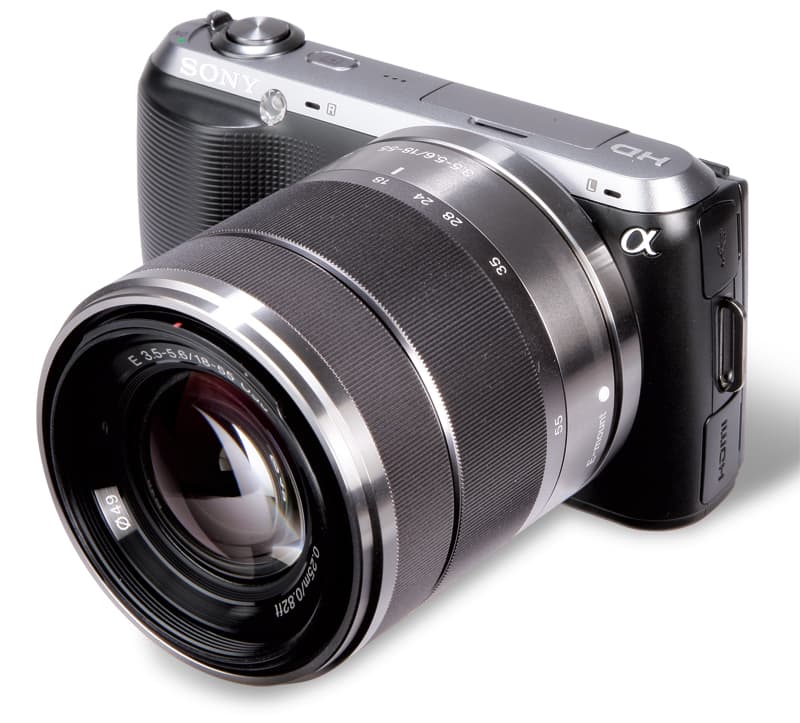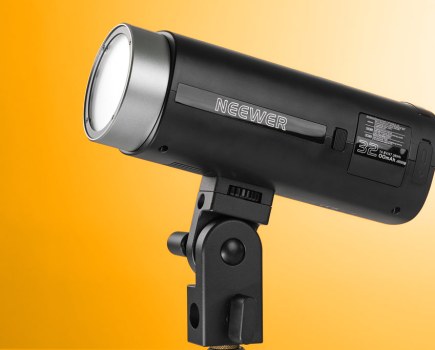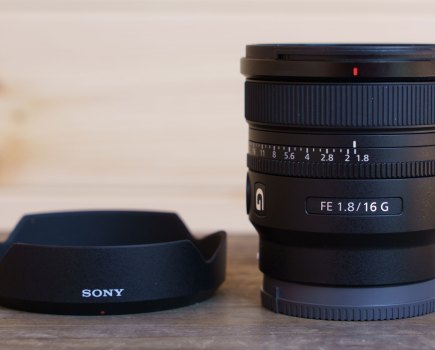The Sony NEX-C3 at a glance:
- 16.2-million-pixel CMOS sensor
- New auto+ mode
- ISO 200-12,800
- 7 new picture effects
- 3D Sweep Panorama
- Focus ‘peaking’ confirmation
- Expected RRP of 630 Euros in Europe when available in August
When Sony launched the NEX system with the NEX-3 and NEX-5 last year, it caused a stir in the compact system camera (CSC) market. Both models featured 14.2-million-pixel sensors, crammed inside the smallest CSC bodies available at the time.The ‘C’ designation of this new model stands for compact and, by shaving a few millimetres off the NEX-5, the NEX-C3 is now the smallest CSC available, yet it features an imposing 16.2-million-pixel APS-C sensor.
A CSC with more than 16 million pixels is not in itself of overwhelming significance; after all, Panasonic has achieved this using a smaller micro four thirds-format sensor. Instead, it is the technology behind the sensor that will be of great interest to many photographers. This is because the NEX-C3’s sensor is a tweaked version of the one used in the Sony Alpha 55, which means it also shares much of the same technology as the base Sony sensor found in the Nikon D7000 and the Pentax K-5.
As we explored in our sensor comparison test of the Alpha 55, D7000 and K-5 and our feature on the death of ISO (both AP 30 April), this 16.2-million-pixel sensor has excellent noise control and a good dynamic range. Using it in a compact system camera shows how serious Sony is about this area of the market, and if the sensor performs as well as it does in the other cameras, the NEX-C3 could offer some serious competition to the Samsung NX100 and Panasonic Lumix DMC-GF2.
However, the original NEX models do not handle particularly well if you make regular adjustments to the shooting settings. Although this was partially rectified with the introduction of new firmware for both cameras, if the NEX-C3 wants to be taken seriously by enthusiast photographers it needs to demonstrate some real improvement in how it handles compared to its two predecessors.
Features
While its feature set is very similar to that of the NEX-3, the NEX-C3 does have a few significant new attributes. The most obvious, of course, is the 16.2-million-pixel CMOS sensor. Once again, images are processed using a Sony Bionz image processor, which is capable of capturing and saving both raw and JPEG images.
The new camera also retains the program, manual, shutter and aperture priority exposure modes of the older model, as well as a variety of scene modes. Both 3D and regular Sweep Panorama are featured, along with an on-screen shooting guide to help beginners.
Also aimed at those photographers stepping up from a compact, or even a mobile phone camera, are the new picture effects. There are seven of these, including retro, high-contrast mono, pop colour and toy camera, all of which can be applied to JPEG images.
Although interesting to play around with, they are clearly aimed at the ‘consumer’ market rather than at serious photographers. That said, if you’re not interested in them don’t let them put you off the camera – just ignore them.
The new auto+ mode takes the standard automatic scene mode selection a step further, allowing various multi-frame shooting modes to be used when appropriate. For example, the auto+ mode is able to detect when you are shooting in dark conditions and set the camera to twilight capture mode.
It will then take a series of six images, which are combined to help avoid camera shake and reduce image noise. The camera can also automatically use multi-shot to apply an HDR effect.
Enthusiast photographers will be pleased to hear that the battery life has been improved from the original NEX-3 by 20%, allowing the new camera to take up to 400 images. Another useful new feature is focus ‘peaking’. When activated in the menu, this aids manual focusing by highlighting the areas of the image that are in focus. However, it seems a little redundant considering that manual focus mode also has the ability to show a magnified section of a scene to aid precise focusing.

Image: The tilting rear screen is really great for low-angle images
Overall, the feature set of the Sony NEX-C3 is impressive, with a range of functions that’s almost identical to that of the full-blown Sony Alpha range.
Build and Handling
You would assume that the NEX-C3, being smaller and lighter than any previous compact system camera, would be awkward to handle. The battery compartment and memory card socket are now separate, helping to keep the camera slim, while the on/off switch and shutter button are now combined into the same unit, which has slightly reduced the size of the handgrip.
My original concerns were unfounded, and in practice the camera fits nicely in the hand, maintaining a comfortable grip. The camera feels very sleek when coupled with the 16mm f/2.8 pancake lens. As you would expect, the 18-200mm f/3.5-5.6 lens does rather dwarf the NEX-C3, but it is still easy to use and handy when travelling.
It isn’t all good news, though. The button layout is unchanged from the NEX-3 and NEX-5, and in our review of the lNEX-5 (AP 5 June 2010) we found that those more used to having full manual control will be frustrated by the lack of direct control over the camera.
Sony quickly addressed the problem with a firmware upgrade that allowed two of the buttons to be customised so that the photographer can directly access the two functions they use the most. In the NEX-C3, the company has taken it a step further and there are now six customisable buttons, situated on the rear of the camera. While this helps to speed things up, only two of the buttons are labelled on-screen, so you must remember which other functions you have allocated to the other four buttons.
I still feel that buttons could be added without spoiling the minimalist design and simple feel of the camera. One could even be placed discreetly on the front of the body.
As mentioned earlier, the ‘C’ in NEX-C3 stands for compact, which hints that Sony may be planning another line in the NEX range in the future. With the body of the NEX-C3 being polycarbonate like the NEX-3, and not magnesium alloy like the NEX-5, we will surely see a more advanced body at some point.
Metering
With the NEX-C3 aimed primarily at point-and-shoot photographers, the metering must produce good exposures without having to perform major post-capture image-editing adjustments.
Like other Sony system cameras we have tested, the evaluative metering of the NEX-C3 produces well-exposed images. In fact, there was only a handful of images for which I needed to adjust the exposure compensation or switch to spot or centreweighted metering.
When the metering is combined with the sensor’s dynamic range and in-camera colour and contrast, the NEX-C3 produces images that require little or no editing.
Autofocus
Panasonic has made major developments in contrast-detection AF recently, with superfast systems found in the Lumix DMC-G2, GH2 and G3. The NEX-C3’s AF is not as fast, although it does appear to be an improvement on earlier NEX models.
For portraits and candid shots, the NEX-C3 is fast enough to cope with small to moderate movements, but to capture faster subjects successfully will take careful prefocusing and a pinch of luck.
When there is time to take an image, the manual focusing magnification and new peaking features make it easy to get the sharpest possible focus.
Noise, Resolution and Sensitivity
At the lowest sensitivity of ISO 200, the NEX-C3 is capable of resolving up to 26 in our resolution chart test, which is on a par with other sensors of 16 million pixels plus. With ISO 200 being the lowest sensitivity setting, using apertures larger than f/2.8 in bright sunlight may cause overexposure.
A high resolution is still visible at ISO 800, and even at ISO 12,800 the resolution is still high at around 20. Noise is well controlled, which is typical of what we have seen previously from the various incarnations of this sensor. However, noise reduction starts to cause a softening of JPEG images at around ISO 800. Mild colour noise is visible in dark areas at ISO 3200, and is prominent at the highest ISO 12,800. This maximum sensitivity should really be treated as an extended mode.
What is particularly gratifying is that when shooting at ISO 200 and 400, images can be underexposed in-camera to preserve highlight details, and then the dynamic range optimiser set to its highest setting to brighten shadow detail, without introducing image noise. When doing this, colours are accurate and an impressive amount of detail can be recovered.
Using Sony’s Image Data Converter raw conversion software to improve sharpening and reduce noise is a cumbersome affair, and results aren’t much better than produced in-camera. However, this is something we have noted before and I expect that it will be easier to get better results with third-party converters.

Image: An impressive amount of shadow detail can be recovered, even in JPEG images
Resolution

Resolution, noise & and dynamic range: These images show 72ppi (100% on a computer screen) sections of images of a resolution chart, captured using the kit lens set to 50mm (75mm equivalent). We show the section of the resolution chart where the camera starts to fail to reproduce the lines separately. The higher the number visible in these images, the better the camera’s detail resolution at the specified sensitivity setting.
White Balance and Colour
Like the NEX-C3’s evaluative metering, the AWB can generally be relied upon to produce good results, and those who are happy to just point and shoot probably need never change it. I did find that the daylight white balance produced more favourable results in early morning sunshine, with the AWB somewhat neutralising the warm glow.
Colours of the in-camera JPEG images are typical of Sony cameras, being bright and quite vivid, and ideal for those who don’t want to spend too much time editing their images. The vivid mode will probably be a little too harsh for most people’s tastes. However, the black & white mode is excellent and images have a nice high-contrast look to them.

Image: The in-camera black & white mode produces good high-contrast images
LCD, Live View and Video
The NEX-C3’s 3in, 921,000-dot widescreen LCD is unchanged from the first generation of NEX cameras. It is tiltable, rather than fully articulated, which is really useful for dynamic low-angle images and is possibly why I took far more landscape-orientation shots than I usually would.
In very bright sunlight, I still feel that an optional electronic viewfinder (EVF) would be beneficial. Although the screen can be used, it could be brighter in the summer sunshine.
Video capture in the NEX-C3 is the same as in the NEX-3, at only 1280×720 pixels rather than the full 1920×1080-pixel resolution of the NEX-5.
Dynamic Range
At the time of going to press, DxO Mark (www.dxomark.com) did not have data for the NEX-C3 but, based on the images I have taken with the camera, I would say that it has a slightly higher dynamic range than the 12.4EV rating of the Alpha 55.
I found that it is possible to underexpose images to retain highlight detail and then brighten shadow areas in software. If you are so inclined, you can produce almost HDR-like images from raw files by underexposing and editing in this way.
However, for the more conventional photographer, the dynamic range, high level of detail and low noise all combine to allow a lot of flexibility when editing raw images. This is all very impressive for a compact system camera.
Verdict
Although Sony clearly had the consumer market in mind when it created the NEX-C3, enthusiast photographers shouldn’t dismiss the camera.
The fully customisable buttons help improve the handling over the first-generation NEX models, although another couple would be an even better improvement. However, it is the quality of the images from this little camera that steals the show. The 16.2-million-pixel, APS-C-format sensor produces great images straight from the camera, which is exactly what you want in a small compact system.
With a total of ten NEX lenses available by the end of next year, a new more powerful flashgun and Sony’s embracing of third-party lenses, NEX cameras have real potential to become a secondary system for most photographers. If only there were a couple more buttons and an EVF…








